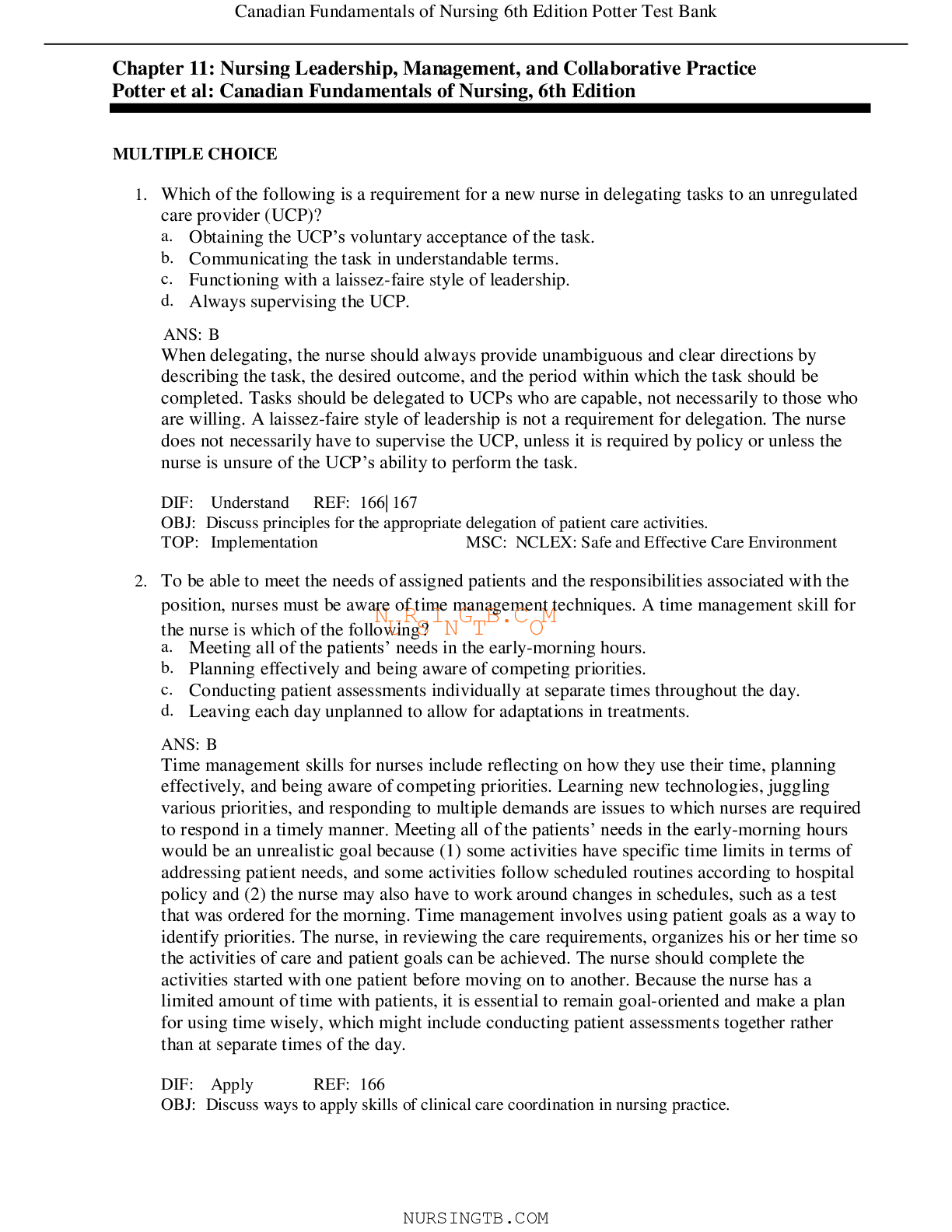*NURSING > EXAM > Potter et al: Canadian Fundamentals of Nursing, 6th Edition/Chapter 43: Urinary Elimination (All)
Potter et al: Canadian Fundamentals of Nursing, 6th Edition/Chapter 43: Urinary Elimination
Document Content and Description Below
Chapter 43: Urinary Elimination Potter et al: Canadian Fundamentals of Nursing, 6th Edition MULTIPLE CHOICE 1. If obstructed, which component of the urination system would cause peristaltic ... waves? 2. When reviewing laboratory results, the nurse should immediately notify the health care provider about which finding? 3. A patient is experiencing oliguria. Which action should the nurse perform first? 4. A patient requests the nurse’s assistance to the bedside commode and becomes frustrated when unable to void in front of the nurse. The nurse understands that the patient is unable to void for which reason? 5. The nurse knows that urinary tract infection (UTI) is the most common health care–associated infection for which of the following reasons? 6. An 86-year-old patient tells the nurse that she is experiencing uncontrollable leakage of urine. Which nursing diagnosis should the nurse include in the patient’s plan of care? 7. A patient has fallen several times in the past week when attempting to get to the bathroom. The patient informs the nurse that he gets up three or four times a night to urinate. Which recommendation by the nurse is most appropriate in correcting this urinary problem? 8. When caring for a patient with urinary retention, the nurse would anticipate an order for which of the following? 9. Upon palpation, the nurse notices that the bladder is firm and distended; the patient expresses an urge to urinate. The nurse should follow up by asking which question? 10. Which of the following is the primary function of the kidneys? 11. While receiving a shift report on a patient, the nurse is informed that the patient has urinary incontinence. Upon assessment, what would the nurse expect to find? MSC: NCLEX: Physiological Integrity 12. Which nursing diagnosis related to alterations in urinary function in an older person should be a nurse’s first priority for action? a. Self-care deficit related to decreased mobility. b. Risk of infection. c. Anxiety related to urinary frequency. d. Impaired self-esteem related to lack of independence. ANS: B In many older persons, muscle tone is poor, which leads to an inability of the bladder to empty completely. Residual urine greatly increases the risk of infection. According to Maslow’s hierarchy of needs, physical health risks should be addressed before emotional/cognitive risks such as anxiety and self-esteem. Decreased mobility can lead to self-care deficit; the nurse’s priority concern for this diagnosis would be infection because the older person must rely on others for basic hygiene. DIF: Apply REF: 1173 OBJ: Identify nursing Diagnosis appropriate for patients with alterations in urinary elimination. TOP: Planning MSC: NCLEX: Physiological Integrity 13. A patient asks about treatment for urinary urge incontinence. The nurse’s best response is which advice to the patient? a. Perform pelvic floor exercises. b. Drink cranberry juice. c. Avoid voiding frequently. d. Wear an adult diaper. ANS: A NURSINGTB.COM Poor muscle tone leads to an inability to control urine flow. The nurse should recommend pelvic muscle strengthening exercises such as Kegel exercises; this solution best addresses the patient’s problem. Drinking cranberry juice is a preventive measure for urinary tract infection. The nurse should not encourage the patient to reduce voiding; residual urine in the bladder increases the risk of infection. Wearing an adult diaper could be considered if attempts to correct the root of the problem fail. DIF: Analyze REF: 1183 OBJ: Identify nursing Diagnosis appropriate for patients with alterations in urinary elimination. TOP: Planning MSC: NCLEX: Physiological Integrity 14. The nurse suspects that a urinary tract infection has progressed to cystitis when the patient complains of which symptom? a. Dysuria. b. Flank pain. c. Frequency. d. Fever and chills. ANS: C Cystitis is inflammation of the bladder; associated symptoms include hematuria and urgency/frequency. Dysuria is a common symptom of a lower urinary tract infection. Flank pain, fever, and chills are all signs of pyelonephritis. DIF: Understand REF: 1168| 1169 OBJ: Compare common alterations in urinary elimination. TOP: Assessment MSC: NCLEX: Physiological Integrity 15. Which assessment question should the nurse ask if stress incontinence is suspected? a. “Does your bladder feel distended?” b. “Do you empty your bladder completely when you void?” c. “Do you experience urine leakage when you cough or sneeze?” d. “Do your symptoms increase with consumption of alcohol or caffeine?” ANS: C Stress incontinence can be related to intra-abdominal pressure that causes urine leakage, as would happen during coughing or sneezing. The patient’s response about the fullness of the bladder would rule out retention and overflow. An inability to void completely can refer to urge incontinence. Physiological causes and medications can affect elimination, but this is not related to stress incontinence. DIF: Apply REF: 1170 (Table 43-2) OBJ: Compare common alterations in urinary elimination. TOP: Planning MSC: NCLEX: Physiological Integrity 16. To obtain a clean-voided urine specimen for a female patient, the nurse should teach the patient to do which of the following? a. Cleanse the urethral meatus from the area of most contamination to least. b. Initiate the first part of the urine stream directly into the collection cup. c. Hold the labia apart while voiding into the specimen cup. d. Drink fluids 5 minutes before collecting the urine specimen. ANS: C NURSINGTB.COM The patient should hold the labia apart to reduce bacterial levels in the specimen. The urethral meatus should be cleansed from the area of least contamination to greatest contamination (front to back). The initial steam flushes out microorganisms in the urethra and prevents bacterial transmission in the specimen. Patients should drink fluids 30 to 60 minutes before giving a specimen. DIF: Understand REF: 1178-1180 (Skill 43-1) OBJ: Obtain urine specimens. TOP: Planning MSC: NCLEX: Physiological Integrity 17. When viewing a urine specimen under a microscope, what would the nurse expect to see in a patient with a urinary tract infection? a. Bacteria. b. Casts. c. Crystals. d. Protein. ANS: A Bacteria indicate a urinary tract infection. Crystals would be seen with renal stone formation. Casts indicate renal alterations. Protein is not visible under a microscope, but its presence indicates renal disease. DIF: Remember REF: 1180| 1181 (Table 43-5) OBJ: Describe characteristics of normal and abnormal urine. TOP: Assessment MSC: NCLEX: Physiological Integrity 18. The nurse would expect the urine of a patient with uncontrolled diabetes mellitus to be which of the following? a. Cloudy. b. Discoloured. c. Sweet smelling. d. Painful. ANS: C Incomplete fat metabolism and buildup of ketones give urine a sweet or fruity odour. Cloudy urine may indicate infection or renal failure. Discoloration of urine may result from various medications. Painful urination indicates an alteration in urinary elimination. DIF: Understand REF: 1177 OBJ: Describe characteristics of normal and abnormal urine. TOP: Assessment MSC: NCLEX: Physiological Integrity 19. What signs and symptoms would the nurse expect to observe in a patient with excessive white blood cells present in the urine? a. Fever and chills. b. Difficulty with urinary elimination. c. Increased blood pressure. d. Abnormal blood glucose level. ANS: A The presence of white blood cells in urine indicates a urinary tract infection. Difficulty with urinary elimination indicatesNbloRckagIe oGr renBa.l dCamMage. Increase in blood pressure is associated with renal disease or damage and some medications. Abnormal blood glucose levels would be seen in someone with ketones in the urine, as this finding indicates the presence of diabetes. DIF: Understand REF: 1204 OBJ: Describe characteristics of normal and abnormal urine. TOP: Assessment MSC: NCLEX: Physiological Integrity 20. For a patient who has severe flank pain and calcium phosphate crystals revealed on urinalysis, the nurse would anticipate an order for which diagnostic test? a. Renal ultrasonography. b. Bladder scan. c. Kidney, ureter, and bladder (KUB) radiography. d. Intravenous pyelography. ANS: D Flank pain and calcium phosphate crystals are associated with renal calculi. Intravenous pyelography allows the health care provider to observe pathological problems such as obstruction of the ureter. Renal ultrasonography is performed to identify gross structures. A bladder scan helps measure the amount of urine in the bladder. A KUB radiograph shows size, shape, symmetry, and location of the kidneys. DIF: Understand REF: 1161| 1182 (Table 43-6) OBJ: Describe the nursing implications of common diagnostic tests of the urinary system. TOP: Planning MSC: NCLEX: Physiological Integrity 21. A nurse is caring for a patient who just underwent intravenous pyelography that revealed a renal calculus obstructing the left ureter. What is the nurse’s first priority in caring for this patient? a. Turn the patient on the right side to alleviate pressure on the left kidney. b. Encourage the patient to increase fluid intake to flush the obstruction. c. Administer narcotic medications to alleviate pain. d. Monitor the patient for fever, rash, and difficulty breathing. ANS: D To perform intravenous pyelography, iodine-based dye is administered to reveal functionality of the urinary system. Many individuals are allergic to shellfish; therefore, the first nursing priority is to assess the patient for an allergic reaction that could be life-threatening. The nurse should then encourage the patient to drink fluids to flush dye used in the procedure. Narcotics can be administered but are not the first priority. Turning the patient on the side does not affect patient safety. DIF: Analyze REF: 1182 (Table 43-6) OBJ: Describe the nursing implications of common diagnostic tests of the urinary system. TOP: Planning MSC: NCLEX: Physiological Integrity 22. Which statement by the patient about upcoming computed tomographic (CT) scanning indicates a need for further teaching? a. “I’m allergic to shrimp, so I should monitor myself for an allergic reaction.” b. “I will complete my bowel prep program the night before the scan.” c. “I will be anaesthetized so that I lie perfectly still during the procedure.” d. “I will ask the technicianNtoUpRlaSyImNuGsicTtBo.eaCseOmMy anxiety.” ANS: C Patients are not put under anaesthesia for a CT scan; instead, the nurse should educate patients about the need to lie perfectly still and about possible methods of overcoming feelings of claustrophobia. The other options are correct. Patients need to be assessed for an allergy to shellfish if they are to receive contrast material for the CT scan. Bowel cleansing is often performed before CT scanning. Listening to music will help the patient relax and remain still during the examination. DIF: Apply REF: 1182 (Table 43-6) OBJ: Describe the nursing implications of common diagnostic tests of the urinary system. TOP: Planning MSC: NCLEX: Safe and Effective Care Environment 23. The nurse is visiting the patient who has a nursing diagnosis of Alteration in urinary elimination, retention. On assessment, the nurse anticipates that this patient will exhibit which of the following? a. Severe flank pain and hematuria. b. Pain and burning on urination. c. A loss of the urge to void. d. A feeling of pressure and voiding of small amounts. ANS: D With urinary retention, urine continues to collect in the bladder, stretching its walls and causing feelings of pressure, discomfort, tenderness over the symphysis pubis, restlessness, and diaphoresis. The sphincter temporarily opens to allow a small volume of urine (<75 mL) to escape, with no real relief of discomfort. Severe flank pain and hematuria are data indicating an upper UTI (pyelonephritis). Pain and burning on urination are symptoms of a lower UTI (such as a bladder infection). Data indicating reflex incontinence would include a loss of the urge to void. DIF: Apply REF: 1171 OBJ: Describe the nursing implications of common diagnostic tests of the urinary system. TOP: Planning MSC: NCLEX: Physiological Integrity 24. A nurse anticipates urodynamic testing for a patient with which symptom? a. Involuntary urine leakage. b. Severe flank pain. c. Presence of blood in urine. d. Dysuria. ANS: A Urodynamic testing is used to evaluate the muscle function of the bladder and to look for the cause of urinary incontinence. Severe flank pain indicates renal calculi; CT scan or intravenous pyelography would be a more efficient diagnostic test. Blood indicates trauma to the urethral or bladder mucosa. Pain on elimination may warrant cultures to check for infection. DIF: Understand REF: 1183 (Table 43-6) OBJ: Describe the nursing implications of common diagnostic tests of the urinary system. TOP: Planning MSC: NNCLUERXS: PIhNysGioTloBgi.caCl IOntMegrity 25. A patient is having difficulty voiding in a bedpan but states that she feels her bladder is full. To stimulation micturition, which nursing intervention should the nurse try first? a. Exiting the room and informing the patient that the nurse will return in 30 minutes to check on the patient’s progress. b. Utilizing the power of suggestion by turning on the faucet and letting the water run. c. Obtaining an order for a Foley catheter. d. Administering diuretic medication. ANS: B To stimulate micturition, the nurse should attempt noninvasive procedures first. Running warm water or stroking the inner aspect of the upper thigh promotes sensory perception that leads to urination. A patient should not be left alone on a bedpan for 30 minutes because this could cause skin breakdown. Catheterization places the patient at increased risk for infection and should not be the first intervention attempted. Diuretics are useful if the patient is not producing urine, but they do not stimulate micturition. DIF: Apply REF: 1186 OBJ: Discuss nursing measures to promote normal micturition and to reduce episodes of incontinence. TOP: Planning MSC: NCLEX: Physiological Integrity 26. A nurse is caring for an 8-year-old patient who is embarrassed about urinating in his bed at night. Which intervention should the nurse suggest to reduce the frequency of this occurrence? a. “Drink your nightly glass of milk earlier in the evening.” b. “Set your alarm clock to wake you every 2 hours, so you can get up to void.” c. “Line your bedding with plastic sheets to protect your mattress.” d. “Empty your bladder completely before going to bed.” ANS: A Nightly incontinence and nocturia are often resolved by limiting fluid intake 2 hours before bedtime. Setting the alarm clock to wake does not correct the physiological problem; nor does lining the bedding with plastic sheets. Emptying the bladder may help with early nighttime urination, but will not affect urine produced throughout the night from late-night fluid intake. DIF: Apply REF: 1186 OBJ: Discuss nursing measures to promote normal micturition and to reduce episodes of incontinence. TOP: Implementation MSC: NCLEX: Physiological Integrity 27. Many individuals have difficulty voiding in a bedpan or urinal while lying in bed for which reason? a. They are embarrassed that they will urinate on the bedding. b. They would feel more comfortable assuming a normal voiding position. c. They feel they are losing their independence by asking the nursing staff to help. d. They are worried about acquiring a urinary tract infection. ANS: B Assuming a normal voiding pNosiRtionIhelGps pBat.ieCnts Mrelax and be able to void; lying in bed is not the typical position in which people void. Men usually are most comfortable when standing; women are most comfortable when sitting and squatting. Embarrassment at using the bedpan and worrying about a urinary tract infection are not related to the lying-in-bed position. Fear of loss of independence is not related to use of the bedpan or urinal. DIF: Understand REF: 1186 OBJ: Discuss nursing measures to promote normal micturition and to reduce episodes of incontinence. TOP: Planning MSC: NCLEX: Physiological Integrity 28. The nurse would anticipate inserting a coudé catheter for which patient? a. An 8-year-old boy undergoing anaesthesia for a tonsillectomy. b. A 24-year-old woman who is going into labour. c. A 56-year-old man admitted for bladder irrigation. d. An 86-year-old woman admitted for a urinary tract infection. ANS: C A coudé catheter has a curved tip that is used for patients with enlarged prostates. This would be indicated for a middle-aged man who needs bladder irrigation. Coudé catheters are not indicated for children or women. DIF: Apply REF: 1189 OBJ: Insert a urinary catheter. TOP: Implementation MSC: NCLEX: Physiological Integrity 29. The nurse knows that which in-dwelling catheter procedure places the patient at greatest risk for acquiring a urinary tract infection? a. Emptying the drainage bag every 8 hours or when half full. b. Kinking the catheter tubing to obtain a urine specimen. c. Placing the drainage bag on the side rail of the patient’s bed. d. Failing to secure the catheter tubing to the patient’s thigh. ANS: C Placing the drainage bag on the side rail of the bed could allow the bag to be raised above the level of the bladder and urine to flow back into the bladder. The urine in the drainage bag is a medium for bacteria; its re-entrance into the bladder can cause infection. The drainage bag should be emptied and output recorded every 8 hours or when needed. Urine specimens are obtained by temporarily kinking the tubing; a prolonged kink could lead to bladder distension. Failure to secure the catheter to the patient’s thigh places the patient at risk for tissue injury from catheter dislodgement. DIF: Apply REF: 1189 OBJ: Discuss nursing measures to reduce urinary tract infection. TOP: Implementation MSC: NCLEX: Safe and Effective Care Environment 30. A nurse notifies the provider immediately if a patient with an in-dwelling catheter does which of the following? a. Complains of discomfort upon insertion of the catheter. b. Places the drainage bag higher than the waist while ambulating. c. Has not collected any urine in the drainage bag for 2 hours. d. Is incontinent of stool and contaminates the external portion of the catheter. ANS: C NURSINGTB.COM If the patient has not produced urine in 2 hours, the physician needs to be notified immediately because this could indicate renal failure. Discomfort upon catheter insertion is unpleasant but unavoidable. The nurse is responsible for maintaining the integrity of the catheter by ensuring that the drainage bag is below the patient’s bladder. Stool left on the catheter can cause infection and should be removed as soon as it is noticed. The nurse should ensure that frequent perineal care is being provided. DIF: Apply REF: 1169 OBJ: Insert a urinary catheter. TOP: Evaluate MSC: NCLEX: Physiological Integrity 31. The nurse would question an order to insert a urinary catheter on which patient? a. A 26-year-old patient with a recent spinal cord injury at T2. b. A 30-year-old patient requiring drug screening for employment. c. A 40-year-old patient undergoing bladder repair surgery. d. An 86-year-old patient requiring monitoring of urinary output for renal failure. ANS: B Urinary catheterization places the patient at increased risk for infection and should be performed only when necessary. Urine can be obtained via clean-catch technique for a drug screening or urinalysis. Spinal cord injury, surgery, and renal failure with critical monitoring of intake and output are all appropriate reasons for catheterization. DIF: Apply REF: 1169 (Table 43-1) OBJ: Insert a urinary catheter. TOP: Implementation MSC: NCLEX: Physiological Integrity 32. When caring for a hospitalized patient with a urinary catheter, which nursing action best prevents the patient from acquiring an infection? a. Inserting the catheter with strict clean technique. b. Performing hand hygiene before and after providing perineal care. c. Fully inflating the catheter’s balloon according to the manufacturer’s recommendation. d. Disconnecting and replacing the catheter drainage bag once per shift. ANS: B Hand hygiene helps prevent infection in patients with a urinary catheter. A catheter should be inserted in the hospital setting with sterile technique. Inflating the balloon fully prevents dislodgement and trauma, not infection. Disconnecting the drainage bag from the catheter creates a break in the system and an open portal of entry and increases risk of infection. DIF: Apply REF: 1172 OBJ: Discuss nursing measures to reduce urinary tract infection. TOP: Implementation MSC: NCLEX: Physiological Integrity 33. An 86-year-old patient asks the nurse what lifestyle changes will reduce the chance of a urinary tract infection. Which response is accurate? a. Urinary tract infections are unavoidable in older people because of a weakened immune system. b. Decreasing fluid intake will decrease the amount of urine with bacteria produced. c. Making sure to cleanse the perineal area from back to front after voiding will reduce the chance of infection. d. Increasing consumption oNf acRidicIfooGds Bsu.chCasMcranberry juice will reduce the chance of infection. ANS: D U S N T O Cranberry juice and other acidic foods decrease adherence of bacteria to the bladder wall. Urinary tract infections are avoidable in older people with proper knowledge and hygiene. Perineal skin should be cleansed from front to back to avoid spreading fecal matter to the urethra. Increasing fluid intake will help flush out bacteria, thus preventing them from residing in the bladder for prolonged periods of time. DIF: Apply REF: 1173 (Box 43-2) OBJ: Discuss nursing measures to reduce urinary tract infection. TOP: Implementation MSC: NCLEX: Physiological Integrity 34. A nurse is providing education to a patient being treated for a urinary tract infection. Which of the following statements by the patient indicates an understanding? a. “Because I’m taking medication, I do not need to worry about proper hygiene.” b. “I should drink 15 to 20 glasses of fluid a day to help flush the bacteria out.” c. “My medication may discolour my urine; this should resolve once the medication is stopped.” d. “I should not have sexual intercourse until the infection has resolved.” ANS: C Some medications turn urine colours; this is normal and will dissipate as the medication leaves the system. Even if the patient is on medication, hygiene is important to prevent spread or reinfection. Fluid intake should be increased to help flush out bacteria; however, 15 to 20 glasses is too much. Sexual intercourse is allowed with a urinary tract infection, as long as good hygiene and safe practices are used. DIF: Apply REF: 1176 OBJ: Discuss nursing measures to reduce urinary tract infection. TOP: Evaluate MSC: NCLEX: Physiological Integrity 35. To reduce patient discomfort during closed catheter irrigation, what should the nurse do? a. Use room temperature irrigation solution. b. Administer the solution as quickly as possible. c. Allow the solution to sit in the bladder for at least 1 hour. d. Raise the bag of irrigation solution at least 30 centimetres above the bladder. ANS: A Using cold solutions, instilling solutions too quickly, and prolonging filling of the bladder can cause discomfort and cramping. To reduce this, ensure that the solution is at room temperature, lower the solution bag so that it is instilled slowly, and drain the bladder fully after an ordered amount of time. DIF: Apply REF: 1201 (Skill 43-4) OBJ: Irrigate a urinary catheter. TOP: Implementation MSC: NCLEX: Physiological Integrity 36. Which observation by the nurse best indicates that bladder irrigation for urinary retention has been effective? a. An output that is larger thNaUn RthSe IamNoGunTtBin.stCilOledM. b. The presence of blood clots or sediment in the drainage bag. c. Reduction in discomfort from bladder distension. d. Visualizing clear urinary catheter tubing. ANS: A An output that is greater than what was irrigated into the bladder shows progress that the bladder is draining urine. The other observations do not objectively help measure the increase in urine output. DIF: Analyze REF: 1176 OBJ: Irrigate a urinary catheter. TOP: Implementation MSC: NCLEX: Physiological Integrity 37. The nurse anticipates urinary diversion from the kidneys to a site other than the bladder for which patient? a. A 12-year-old girl with severe abdominal trauma. b. A 24-year-old man with severe genital warts around the urethra. c. A 50-year-old man who has recently undergone prostatectomy. d. A 75-year-old woman with end-stage renal disease. ANS: A Urinary diversion would be needed in a patient with abdominal trauma, which might cause injury to the urinary system. Genital warts are not a reason for urinary diversion. Patients with a prostatectomy may require intermittent catheterization after the procedure. End-stage renal disease would not be affected by rerouting the flow of urine. DIF: Apply REF: 1171 OBJ: Compare common alterations in urinary elimination. TOP: Implementation MSC: NCLEX: Physiological Integrity MULTIPLE RESPONSE 1. Which nursing actions are acceptable when a urine specimen is collected? (Select all that apply.) a. Growing urine cultures for up to 12 hours. b. Labelling all specimens with date, time, and initials. c. Wearing gown, gloves, and mask for all specimen handling. d. Allowing the patient adequate time and privacy to void. e. Squeezing urine from diapers into a urine specimen cup. f. Transporting specimens to the laboratory in a timely manner. g. Placing a plastic bag over the child’s urethra to catch urine. ANS: B, D, F, G All specimens should be labelled appropriately and processed in a timely manner. Patients should be allowed time and privacy to void. Children may have difficulty voiding; attaching a plastic bag gives the child more time and freedom to void. Urine cultures can take up to 48 hours to develop. Gown, gloves, and mask are not necessary for specimen handling unless otherwise indicated. Urine should not be squeezed from diapers. DIF: Understand REF: 1177-1180 OBJ: Obtain urine specimens. TOP: Implementation MSC: NCLEX: Physiological Integrity 2. Which of the following are inNdUicRatSioInsNfGorTirBri.gaCtiOngMa urinary catheter? (Select all that apply.) a. Sediment occluding within the tubing. b. Blood clots in the bladder after surgery. c. Rupture of the catheter balloon. d. Presence of renal calculi. ANS: A, B Catheter irrigation is used to flush and remove blockage that may be impeding the catheter from properly draining the bladder. It is also used to remove blood clots in the bladder after surgery. A ruptured catheter balloon will involve extensive follow-up and possible surgery to remove the particles. Renal calculi obstruct the ureters and therefore the flow of urine before it reaches the bladder. DIF: Apply REF: 1198-1200 OBJ: Irrigate a urinary catheter. TOP: Implementation MSC: NCLEX: Physiological Integrity 3. Which of the following symptoms are most closely associated with uremic syndrome? (Select all that apply.) a. Fever. b. Nausea and vomiting. c. Headache. d. Altered mental status. e. Dysuria. ANS: B, C, D Uremic syndrome is associated with end-stage renal disease. Signs and symptoms include headache, altered mental status, coma, seizures, nausea, vomiting, and pericarditis. DIF: Remember REF: 1171| 1172 OBJ: Compare common alterations in urinary elimination. TOP: Implementation MSC: NCLEX: Physiological Integrity 4. The nurse understands that peritoneal dialysis and hemodialysis involve which processes to clean the patient’s blood? (Select all that apply.) a. Gravity. b. Osmosis. c. Diffusion. d. Filtration. ANS: B, C Osmosis and diffusion are the two processes used to clean the patient’s blood in both types of dialysis. In peritoneal dialysis, osmosis and dialysis occur across the semi-permeable peritoneal membrane. In hemodialysis, osmosis and dialysis occur through the filter membrane on the artificial kidney. In peritoneal dialysis, the dialysate flows by gravity out of the abdomen. Gravity has no effect on cleansing of the blood. Filtration is the process that occurs in the glomerulus as blood flows through the kidney. DIF: Understand REF: 1172 OBJ: Identify two modalities of renal replacement therapy. TOP: Implementation MSC: NCLEX: Physiological Integrity NURSINGTB.COM [Show More]
Last updated: 1 year ago
Preview 1 out of 15 pages
Instant download

Buy this document to get the full access instantly
Instant Download Access after purchase
Add to cartInstant download
Reviews( 0 )
Document information
Connected school, study & course
About the document
Uploaded On
Aug 08, 2021
Number of pages
15
Written in
Additional information
This document has been written for:
Uploaded
Aug 08, 2021
Downloads
0
Views
42

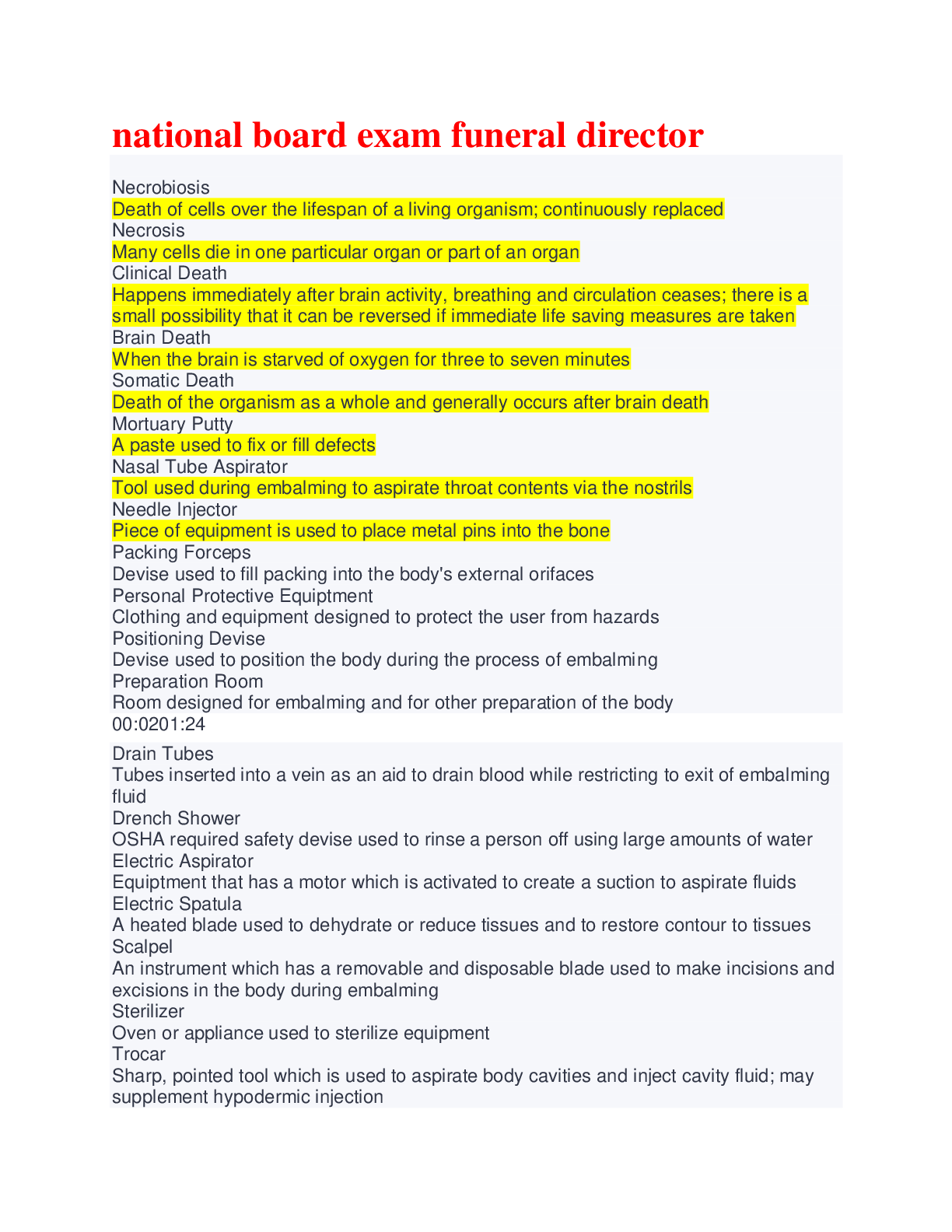
 (1).png)
.png)
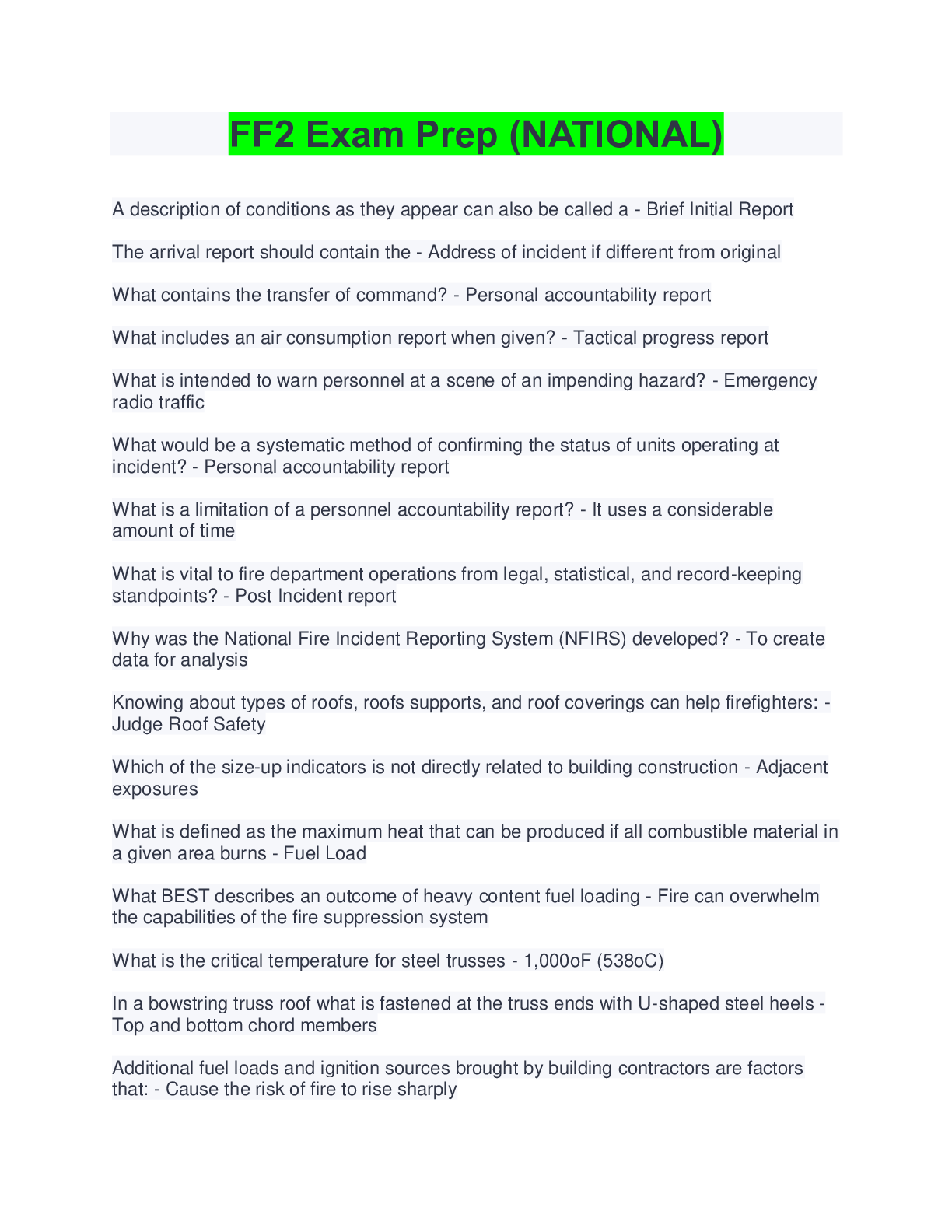
.png)
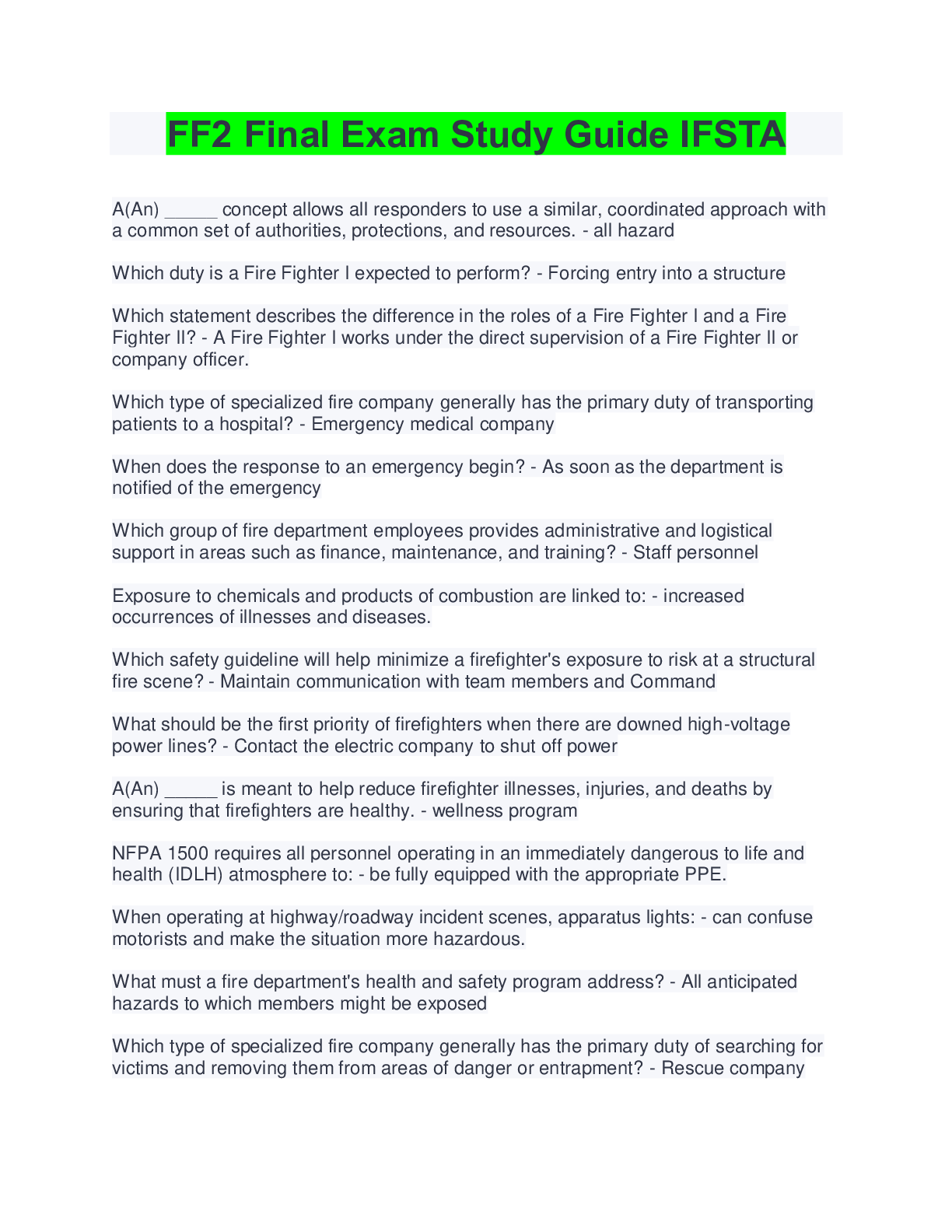
 (1).png)
 (1).png)
.png)
 (1).png)
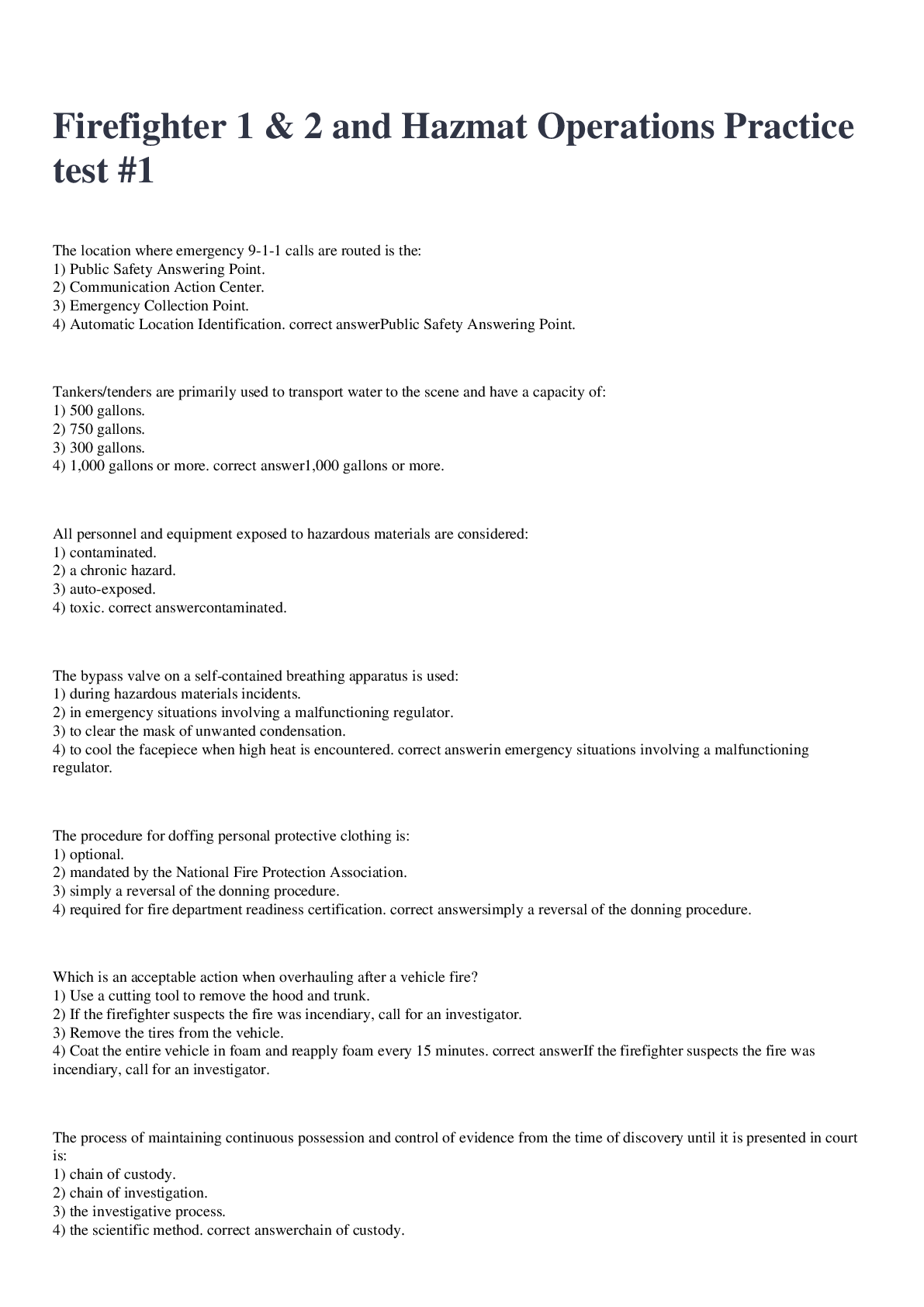
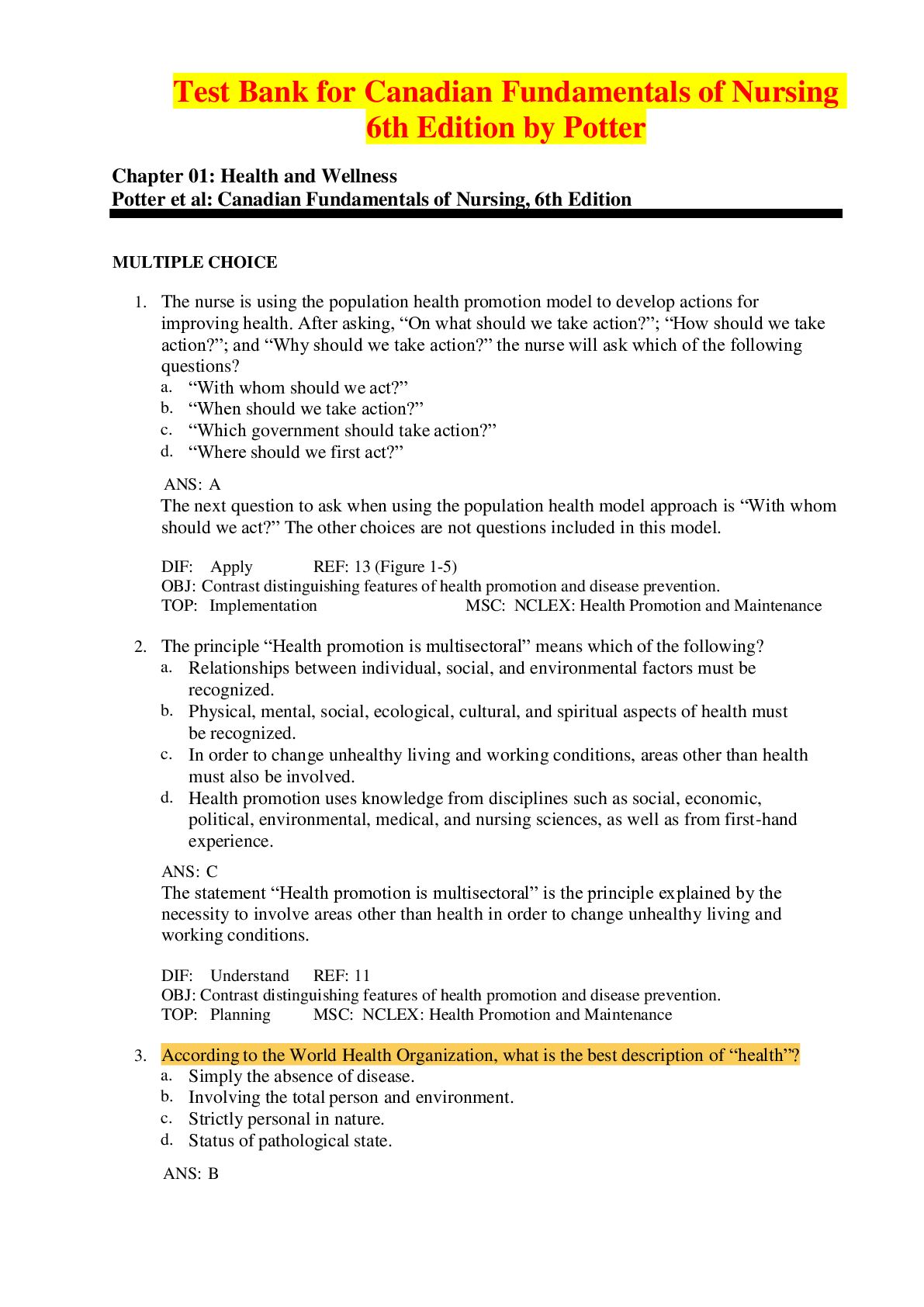
.png)
